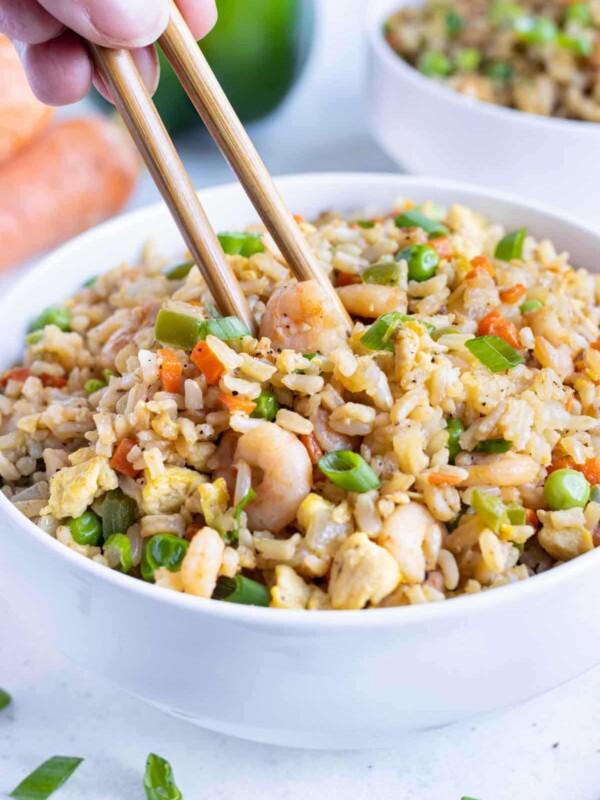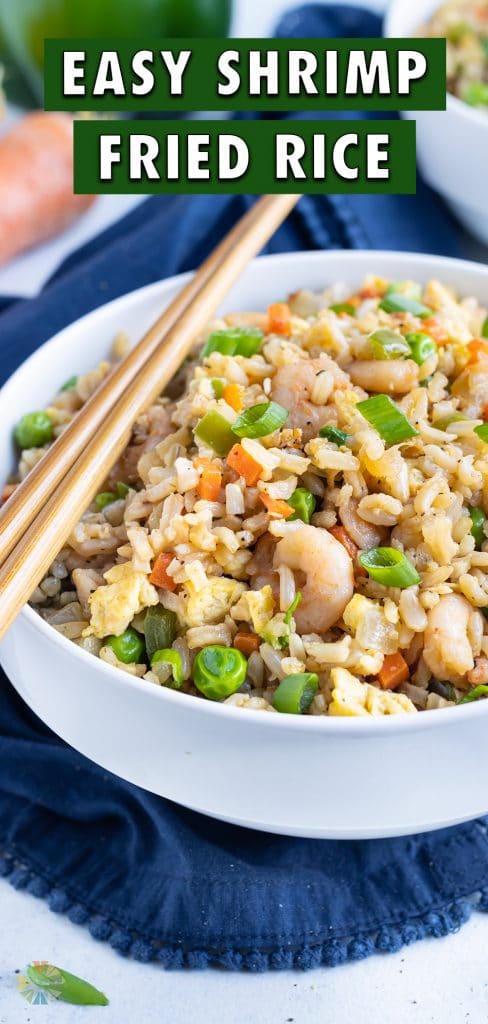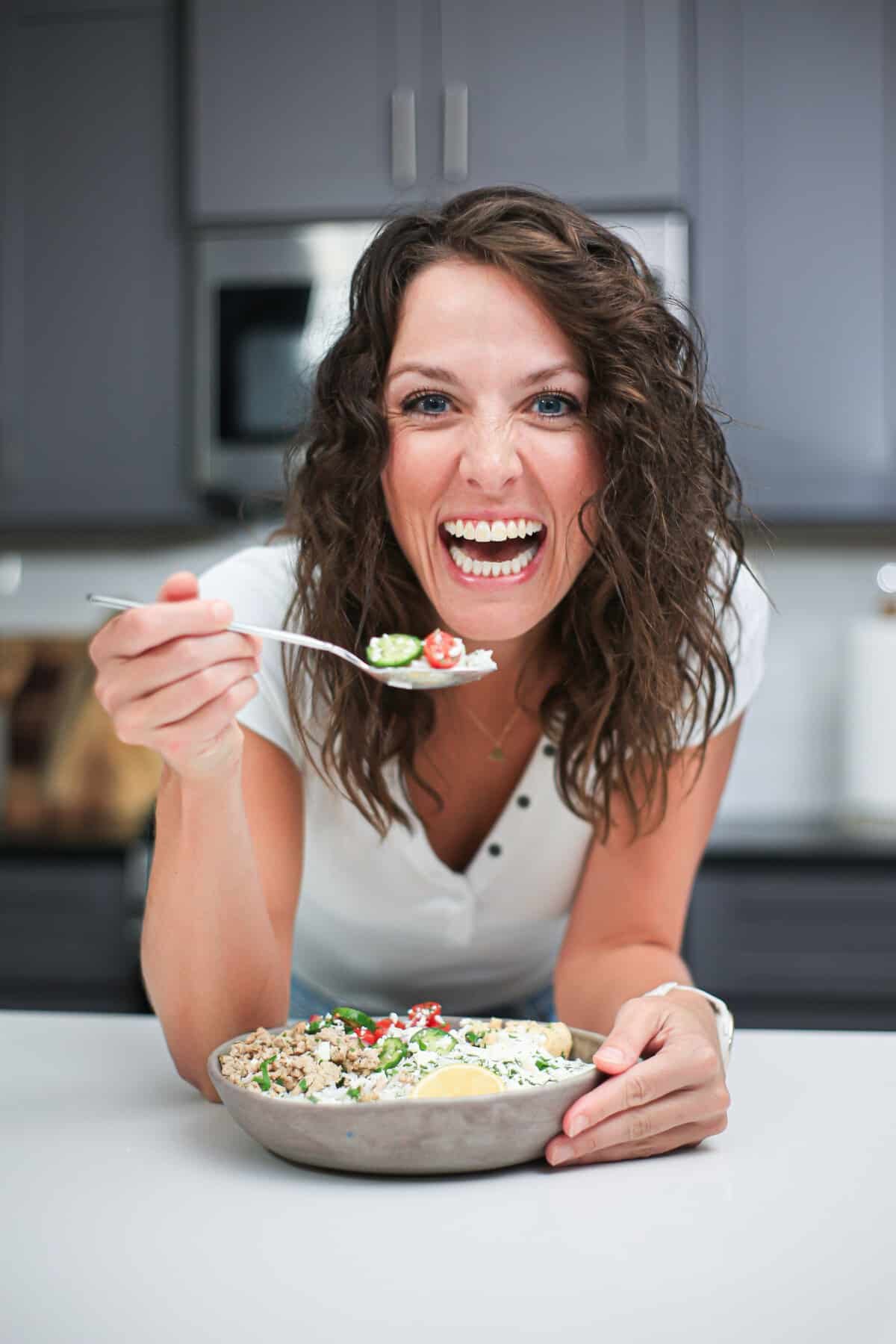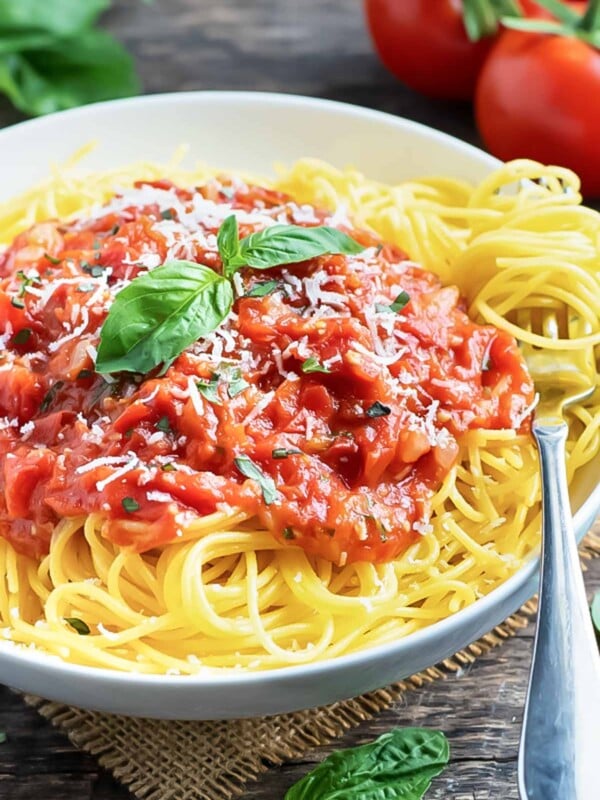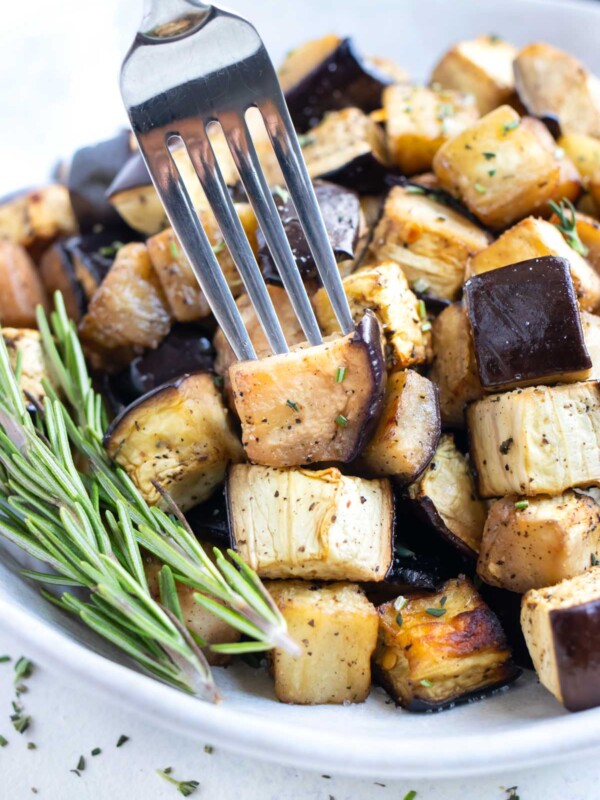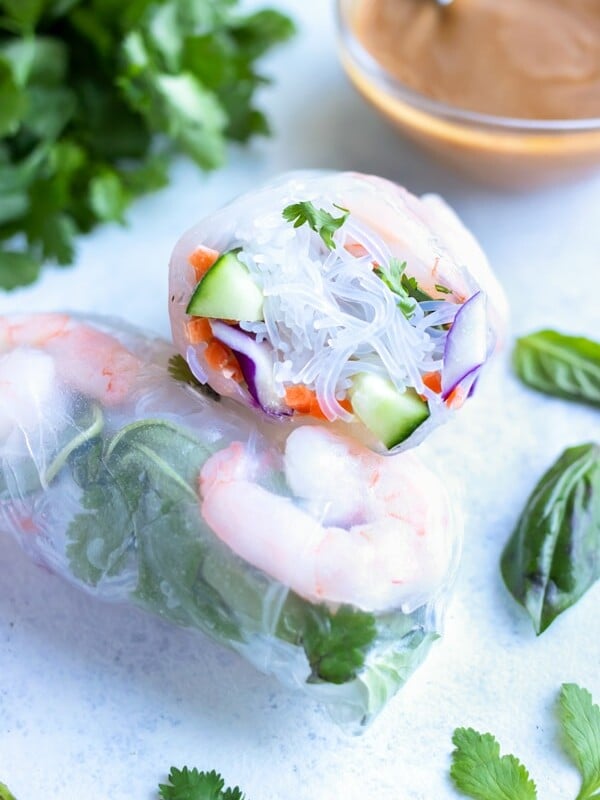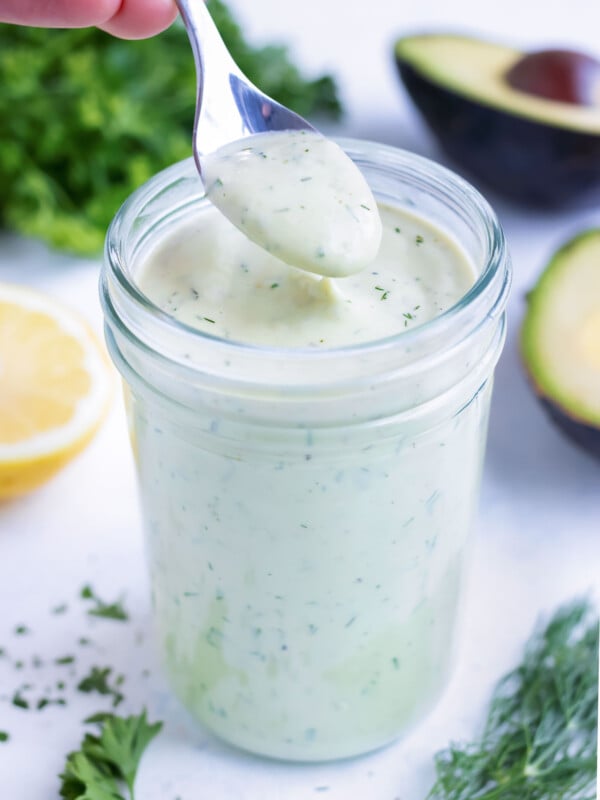Table of Contents
Fried rice is one of my favorite weeknight dinners to make at home. It’s so quick and easy to throw together, and I almost always have all of the ingredients for it close at hand.
I’ve made many different variations of it over the years – Chicken Fried Rice, Vegetable Fried Rice, even a Cauliflower Pineapple Fried Rice. But the best by far has been this Shrimp Fried Rice recipe!
Ingredients
For the exact measurements and detailed instructions, you can jump to the recipe.
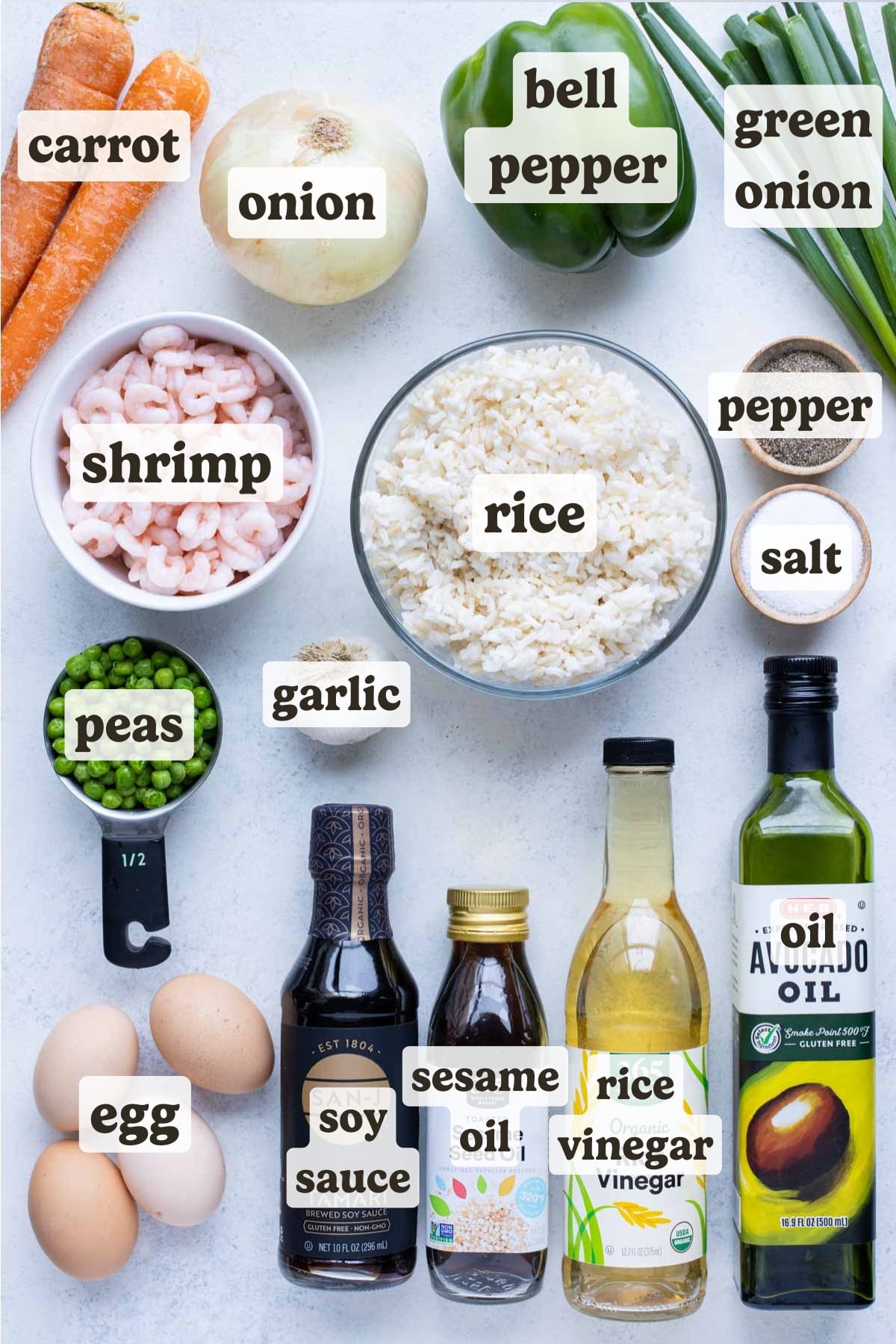
- Shrimp. A small variety of peeled, deveined, tail-off shrimp – such as 100/200 count-per-pound – is recommended for this recipe. Fresh is ideal, but frozen will also do. If you cannot find shrimp this small, larger shrimp cut into bite-sized pieces will work.
- Vegetables. Carrots, onions, and peas are the usual choices for fried rice, but any diced vegetables will do – this recipe calls for bell peppers and green onions, as well. Frozen may also be used, but it is recommended to let them thaw and drain ahead of time.
- Garlic. Fresh cloves of garlic are ideal, but if those are unavailable, then ⅛-teaspoon of garlic powder may be substituted for each clove. For more information, see How to Mince Garlic.
- Eggs. Any kind of large egg may be used for this recipe, but organic eggs usually taste the best and are healthier for you.
- Rice. Long-grain white rice is recommended, but brown rice, basmati rice, or jasmine rice will work too. Ideally, the rice should be cooked the day before and used as leftovers.
- Soy sauce or Tamari sauce. Soy sauce is light and salty in flavor, while Tamari sauce is rich and gluten-free, with heavier notes of soy – either will work for this dish. However, a well-vetted brand such as Kikkoman or San-J should be used, as they are higher quality than store brand.
- Rice wine vinegar. This provides a sweet, tangy acidity which helps to cut through the oiliness of the fried rice, and provide contrast. If it isn’t available, white wine vinegar may be substituted.
- Toasted sesame seed oil. This ingredient should be used sparingly, because its powerful, deep, nutty flavor packs a punch, and can easily overwhelm simple dishes.
How to Make Shrimp Fried Rice
Jump to the recipe for the full instructions, ingredient amounts, and a printable recipe.
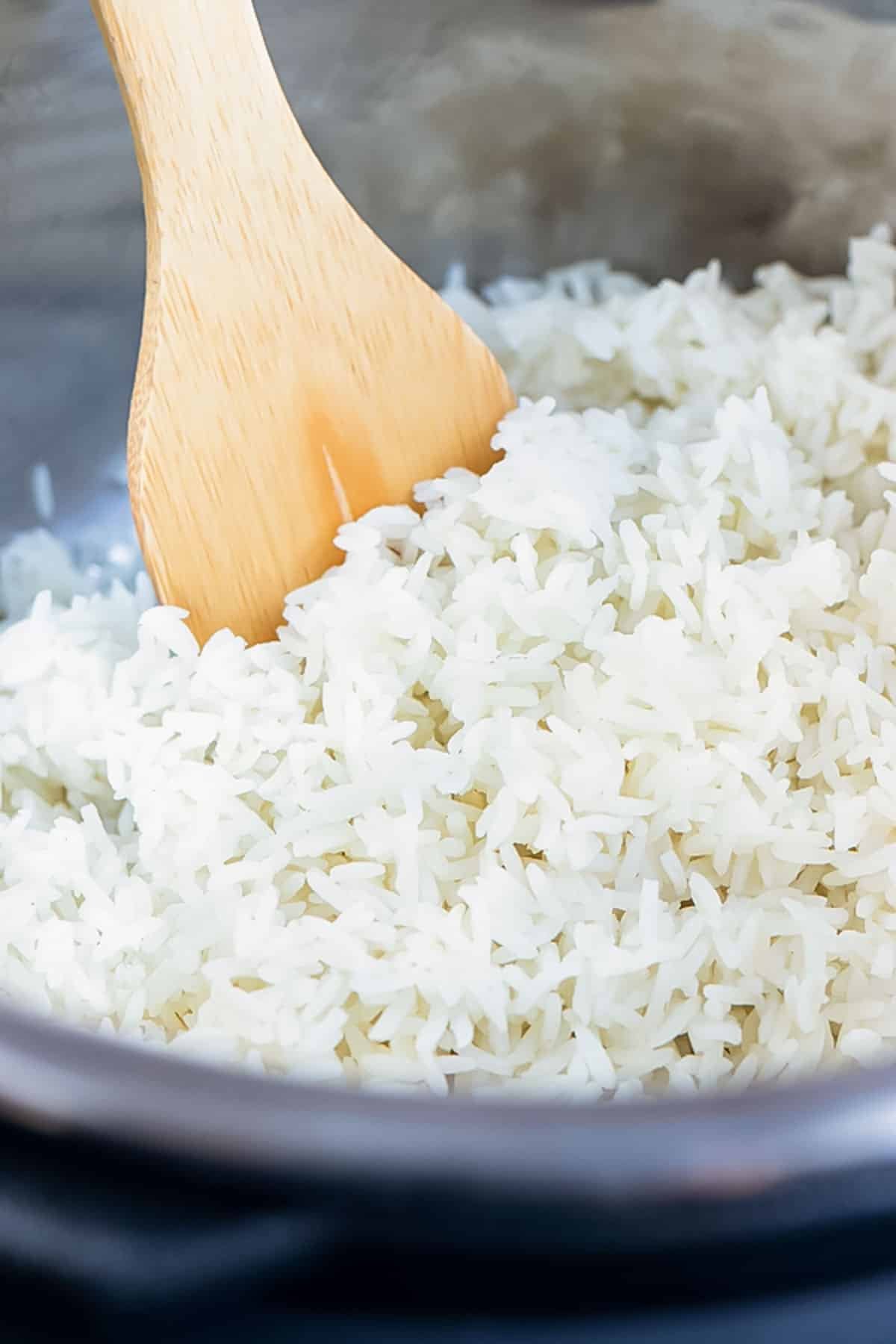
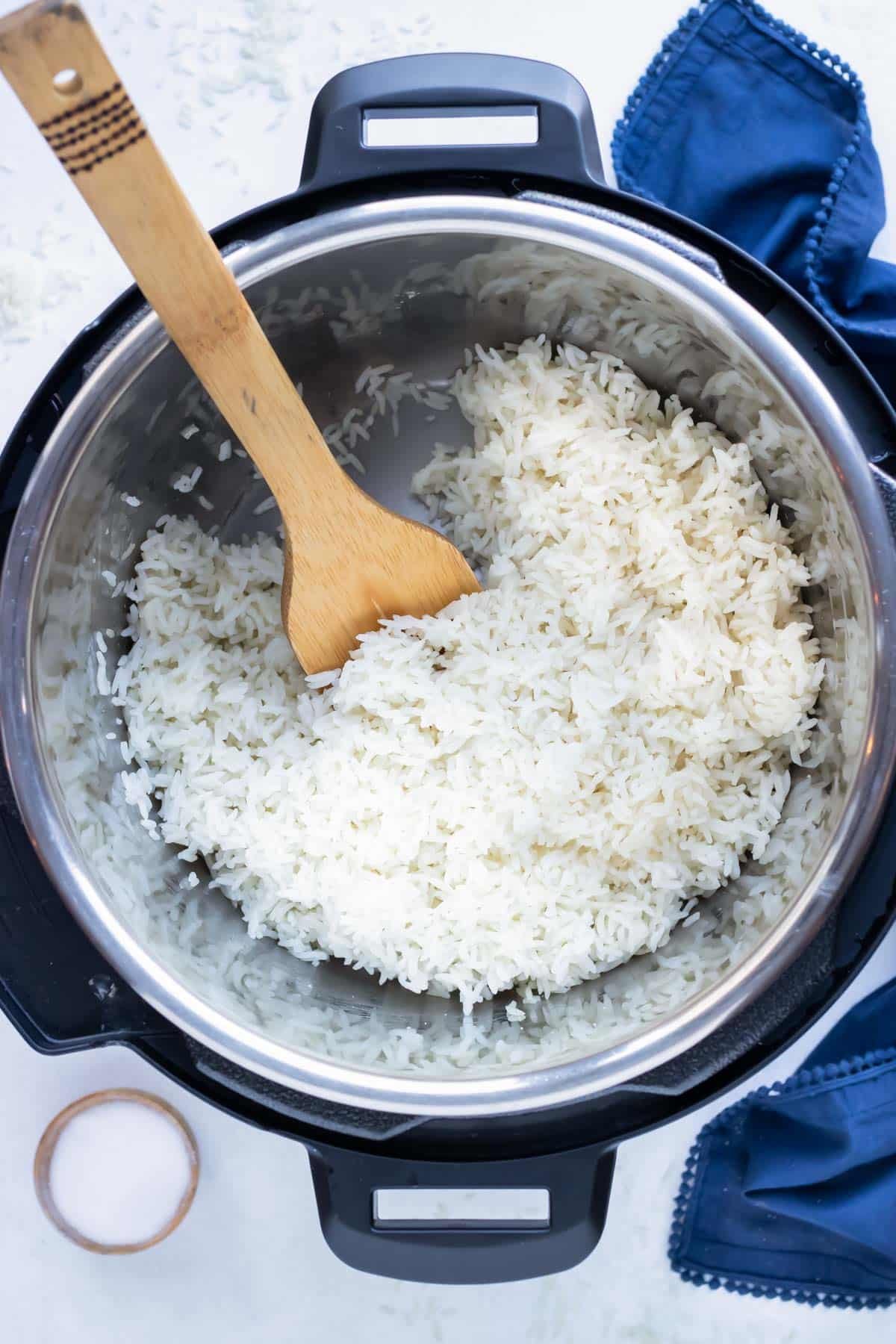
- Cook the rice. The uncooked rice should first be rinsed repeatedly under cold water in a strainer, until the water runs clear. This removes excess starch clinging to the rice, which can cause stickiness and prevent the rice from breaking apart easily. Freshly cooked rice can also be spread out, uncovered, in a tray or shallow container in the fridge overnight, so that it all dries out evenly.
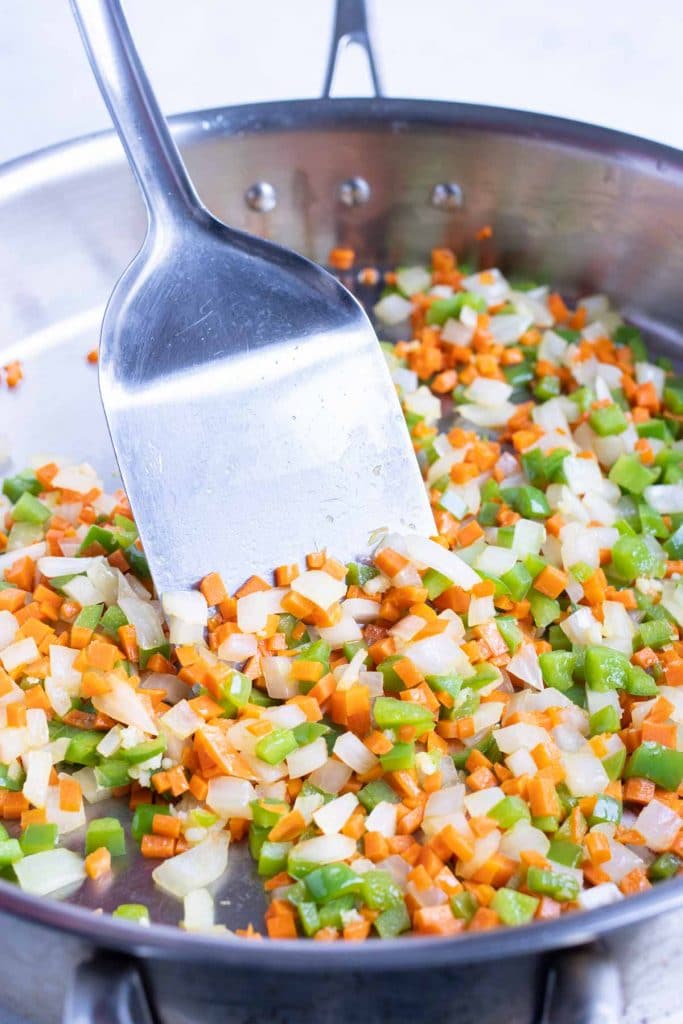
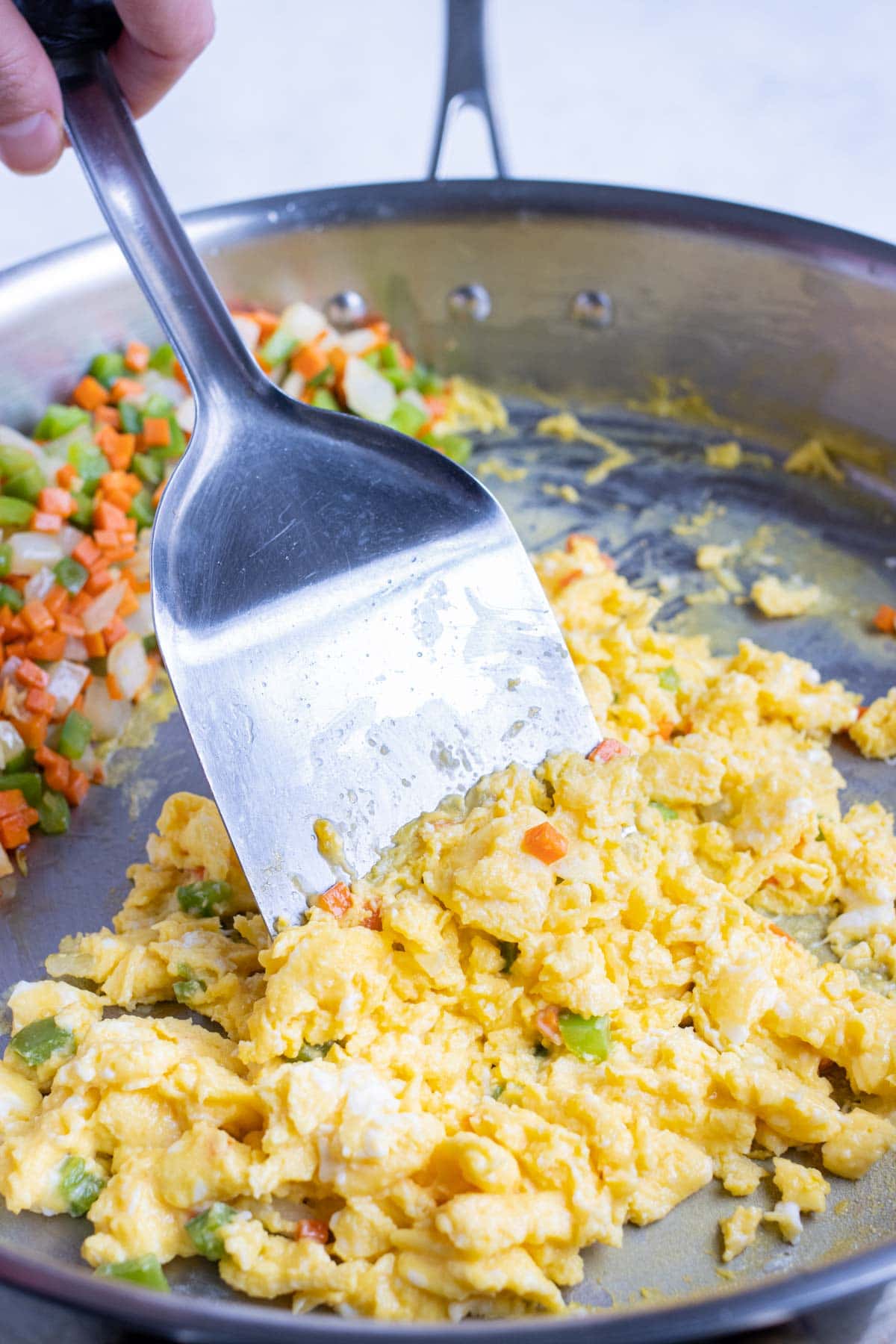
- Sauté the vegetables Finely dice the carrots, onion, and bell pepper into ½-inch pieces, and chop the garlic to a fine mince. In a large wok or skillet, heat the oil over medium heat on the largest stove burner, and add the carrots, pepper, and onion. Sauté the vegetables for 3-5 minutes. Add the garlic, and sauté 1 minute more, or until the garlic is fragrant and only slightly soft.
- Scramble the eggs. Whisk together the eggs in a small bowl. Push the vegetables to one side of the pan. Drizzle more oil into the skillet, and add the eggs. Season them with salt and pepper, and scramble for 2-3 minutes, until cooked all the way through. Break apart the cooked eggs into smaller, bite-sized pieces, and stir them back in with the vegetables.
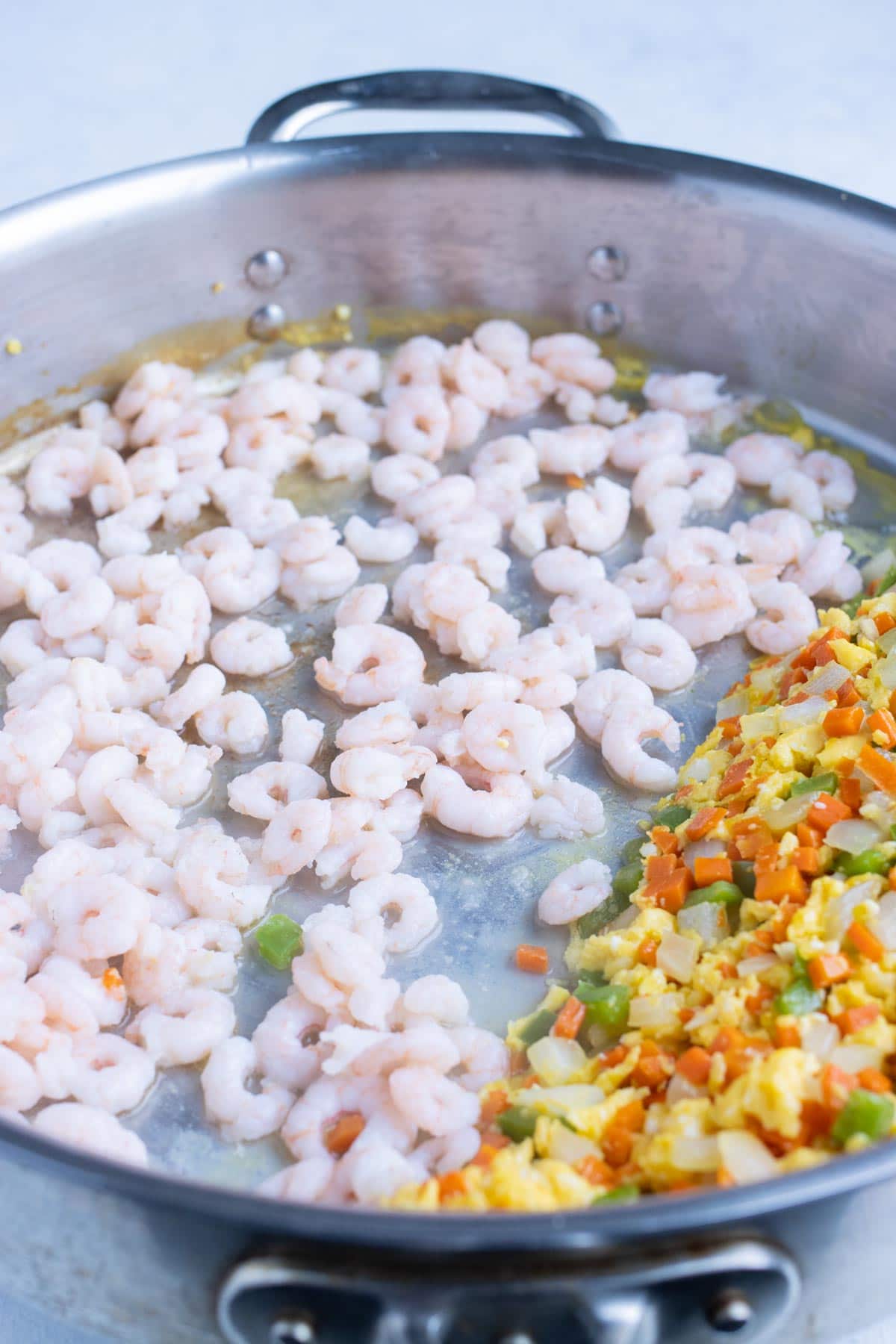
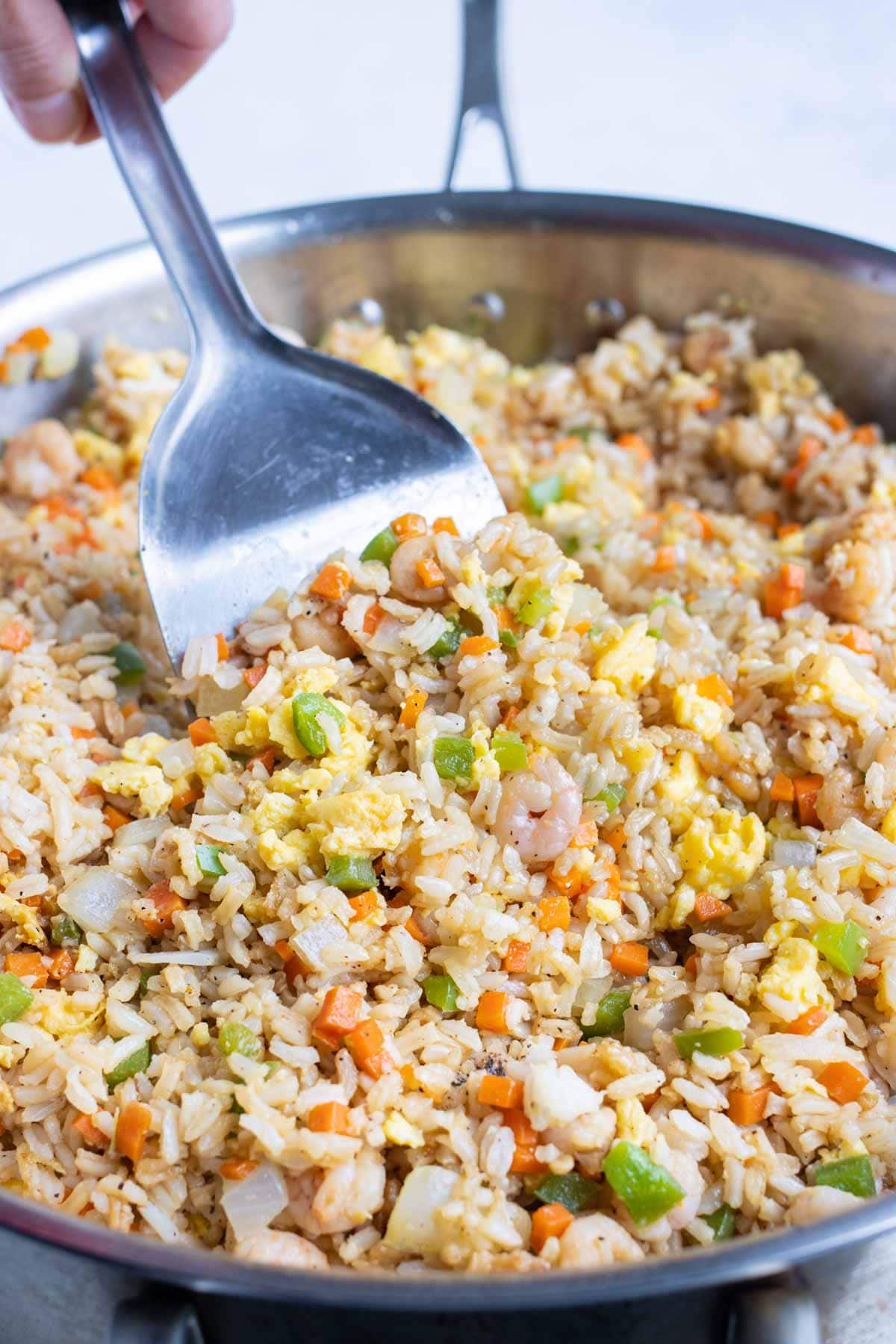
- Add the shrimp. Push the egg and vegetable mixture to one side of the skillet. Drizzle another 1 tablespoon of oil into the empty side to begin heating. Add the shrimp to the empty part of the skillet, and sauté them over medium heat for 1-2 minutes, or until lightly fried. Mix together the seared shrimp, vegetables, and eggs, making sure to scrape up any browned bits from the bottom of the pan.
- Fry the rice. Add the cooked rice, and mix well with the soy sauce, sesame oil, and rice vinegar. Taste, and add another ½ teaspoon of salt to preference, if needed. Break up any clumps of rice to create a loose texture that will allow it to fry evenly, and continue cooking over medium heat for 10 minutes.


- Add the peas. When the rice has almost reached the desired level of crispness, stir in the thawed frozen peas and cook for another 4 minutes. Putting the peas in last prevents them from overcooking and getting mushy.
- Serve the fried rice up in a bowl, and garnish with some sliced green onions. Enjoy!
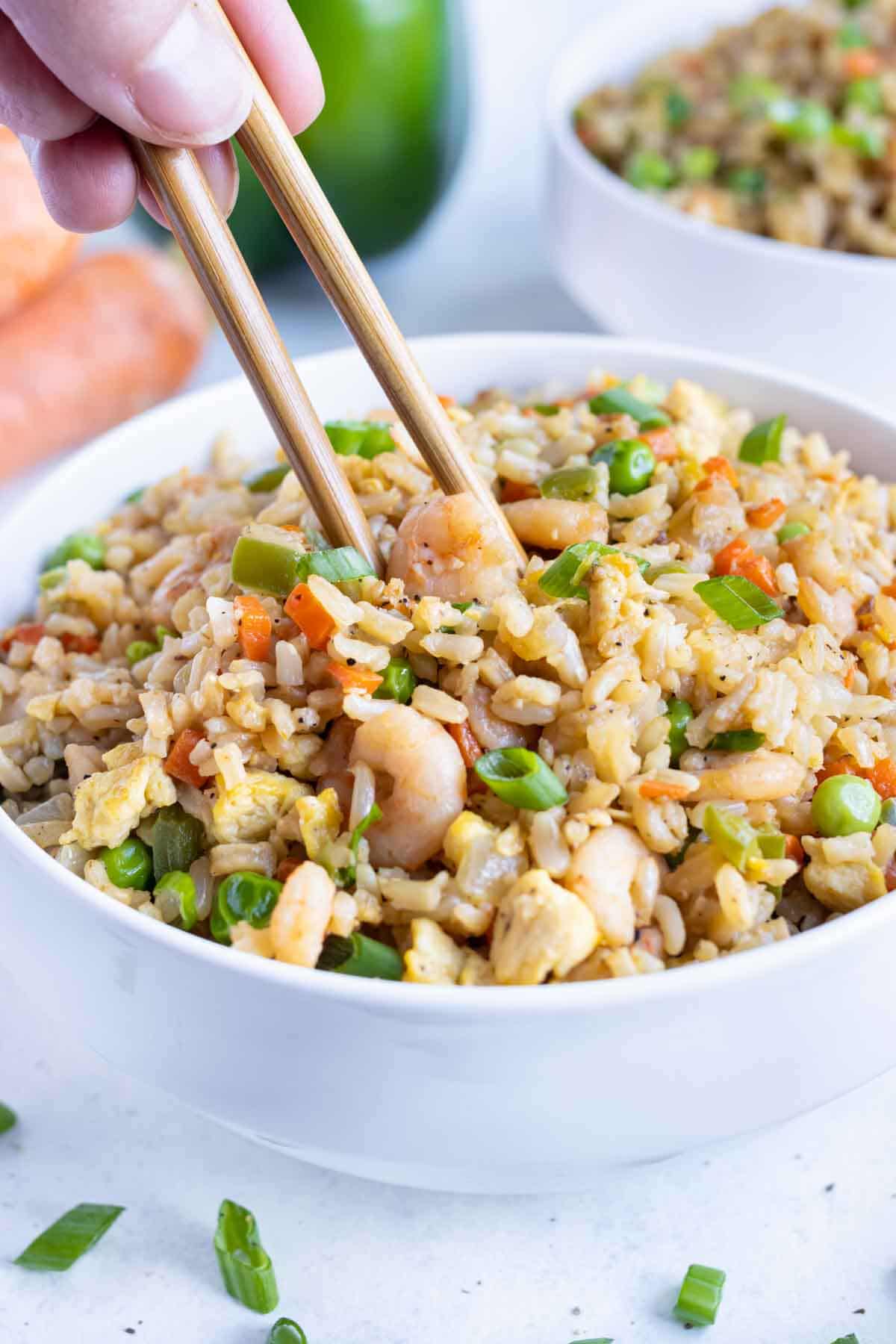
Meal Prep and Storage
- Prep-Ahead: The rice can and should be cooked up to 1-2 days ahead, to dry it out and make the texture better suited for frying. The vegetables can also be cut ahead of time, and will keep in the fridge for up to 2-3 days.
- Storage: With or without shrimp, this dish can be stored in an airtight container in the fridge for up to 3-4 days.
- Freezing: Fried rice can be frozen in an airtight container or sealed Ziploc freezer bag for up to 3-4 months. Individual servings can also be portioned out to make reheating easier.
- Reheating: It is recommended to reheat fried rice in a skillet with a bit of oil over medium-low heat until warmed through. Reheating in the microwave will suffice as well, but be aware that the shrimp may be more tough or rubbery in texture with this method.
FAQs
Chinese restaurants often utilize very big, professional-grade woks and stove burners which fry rice at a very high temperature that most home cooks cannot replicate, giving it a much more crisp texture without the rest of the ingredients overcooking. Many Chinese restaurants also still add monosodium glutamate (MSG) to their dishes, giving them a greater depth of flavor.
There’s no need to boil or cook shrimp prior to frying it in the skillet for fried rice – in fact, this is likely to result in rubbery, overcooked shrimp with not much flavor. The high temperature for frying ensures that the short cooking time for the shrimp is sufficient to cook them through.
If using precooked shrimp, simply add them to the rice later in the cooking process to ensure they are fully heated through to a safe temperature, without overcooking.
Fresh shrimp will always taste better than frozen, but the latter holds the distinct benefit of not having to be immediately bought anew for every dish. Additionally, when reheating leftovers, it’s very easy to add more frozen shrimp by the handful without overcooking them the second time over.
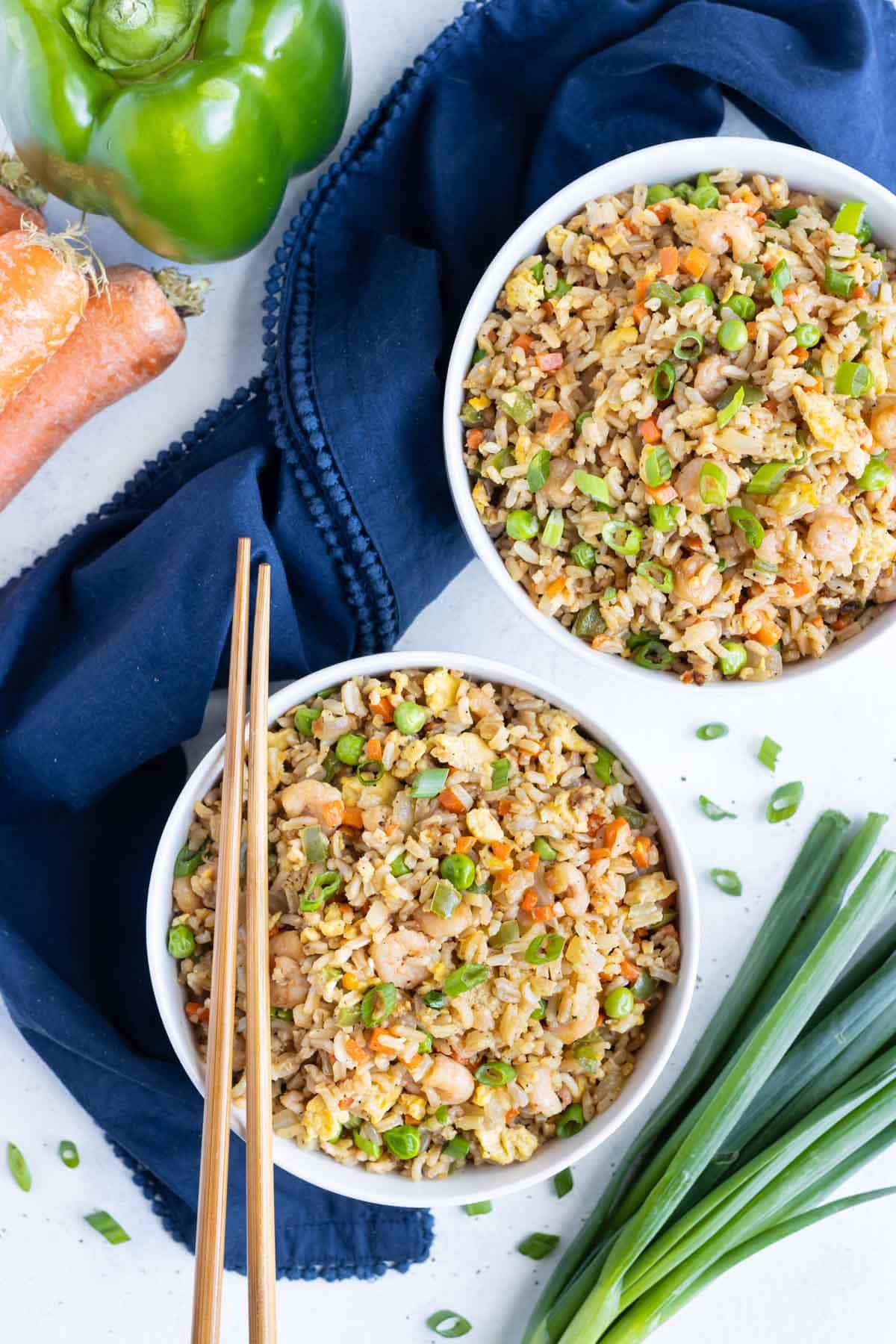
What to Serve with Fried Rice?
Shrimp Fried Rice can make for an excellent meal in its own right, but also pairs beautifully with other dishes for that Chinese restaurant feeling:
A light form of protein like shrimp goes very well with equally light sides such as Vietnamese Fresh Spring Rolls, Thai Zucchini Noodle Salad, or P.F. Chang’s Chicken Lettuce Wraps.
It can also serve as a side dish itself to heavier proteins such as Teriyaki Salmon, General Tso’s Chicken, or Mongolian Beef.
More Stir-Fry Recipes
Get the most out of your skillet or wok by trying out some of these other amazing stir-fried recipes:
Egg Roll in a Bowl, Cashew Chicken Stir Fry, and Thai Basil Chicken are some of the best one-skillet dinner recipes!
This Teriyaki Shrimp Stir Fry and Beef and Broccoli Stir Fry also comes together fast.
This Korean Japchae does take a little more time, but it’s SO worth the effort to get all of the veggies and flavor-packed meat in one dish.
Tap stars to rate!
Easy Shrimp Fried Rice Recipe
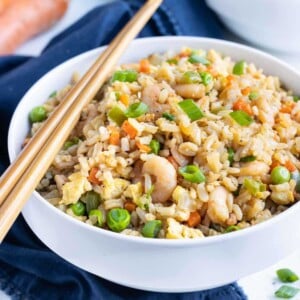
email this recipe!
Ingredients
- ¾ pound shrimp about 100/200 count per pound
- 2 medium-sized carrots peeled and finely diced
- 1 cup green bell pepper finely diced
- 1 cup sweet onion finely diced
- 4 tablespoons oil olive or avocado oil, divided
- 2 cloves garlic finely minced
- 4 eggs whisked
- 5 cups cooked rice white or brown*
- ⅓ cup soy sauce or Tamari
- 2 tablespoons rice vinegar
- 2 teaspoons sesame oil toasted
- 1 teaspoon salt to taste
- ¼ teaspoon black pepper to taste
- ½ cup frozen peas thawed
- Green onions optional
Instructions
- In a large wok or skillet, over medium heat combine 2 tablespoons oil, bell peppers, onions, and carrots. Sauté for 3-5 minutes over medium heat, or until they start to become tender.2 medium-sized carrots, 1 cup green bell pepper, 1 cup sweet onion
- Add minced garlic, and sauté another 1 minute, or until fragrant.2 cloves garlic
- Whisk eggs together in a medium-sized bowl. Either push all vegetables to one side of the skillet, or remove and place on a separate plate.4 eggs
- Drizzle 1 tablespoon of oil in the spot you have cleared and add in the whisked eggs, ½ teaspoon salt and black pepper. Scramble in that spot for 2-3 minutes, or until cooked. Once cooked, you can combine the eggs with the rest of the vegetable mixture, and either move it back to the side of the skillet or remove and place on a separate plate.¼ teaspoon black pepper
- Add 1 additional tablespoon of oil to the cleared spot in the pan. Add in shrimp and sauté for 1-2 minutes, or until they are lightly fried. Mix together the shrimp, vegetables, and eggs and then add in the cooked rice.¾ pound shrimp, 5 cups cooked rice
- Pour in soy sauce, rice vinegar, sesame oil, and ½ teaspoon of salt, to taste. Cook over medium heat for 10 minutes, stirring occasionally.⅓ cup soy sauce, 2 tablespoons rice vinegar, 2 teaspoons sesame oil
- Mix in thawed peas during the last 4 minutes of cooking and mix everything together.½ cup frozen peas
- If you like extra crispy fried rice, let rice sit over medium to medium-high heat for a full minute before mixing again. Rice likes to stick to the bottom of the pan so be sure to scrape all of the crispy goodness off of it! Repeat this process until it has reached your desired crispiness.
- Serve immediately with finely chopped green onions and enjoy!Green onions
Tap stars to rate!
Video
Notes
- Rice: Day-old rice will give you the crispiest texture.
- Protein: Omit the shrimp, and/or use a meat-free alternative. Prepared a certain way, king oyster mushrooms are sometimes used as a meatless substitution for shrimp.
- Veggies: Add more veggies, and consider additional varieties like cabbage, snow peas, green beans, or broccoli. Substitute white rice for brown rice or cauliflower rice.
- Prep-Ahead: The rice can and should be cooked up to 1-2 days ahead, to dry it out and make the texture better suited to frying. The vegetables can also be cut into pieces ahead of time, and will keep in the fridge for up to 2-3 days.
- Storage: With or without shrimp, this dish can be stored in an airtight container in the fridge for up to 3-4 days.
- Freezing: Fried rice can be frozen in an airtight container or sealed Ziploc freezer bag for up to 3-4 months. Individual servings can also be portioned out to make reheating easier.
- Reheating: It is recommended to reheat fried rice in a skillet over medium-low heat until warmed through. Reheating in the microwave will suffice as well, but be aware that the shrimp may be more tough or rubbery in texture with this method.
Nutrition
Nutrition information is automatically calculated, so should only be used as an approximation.

